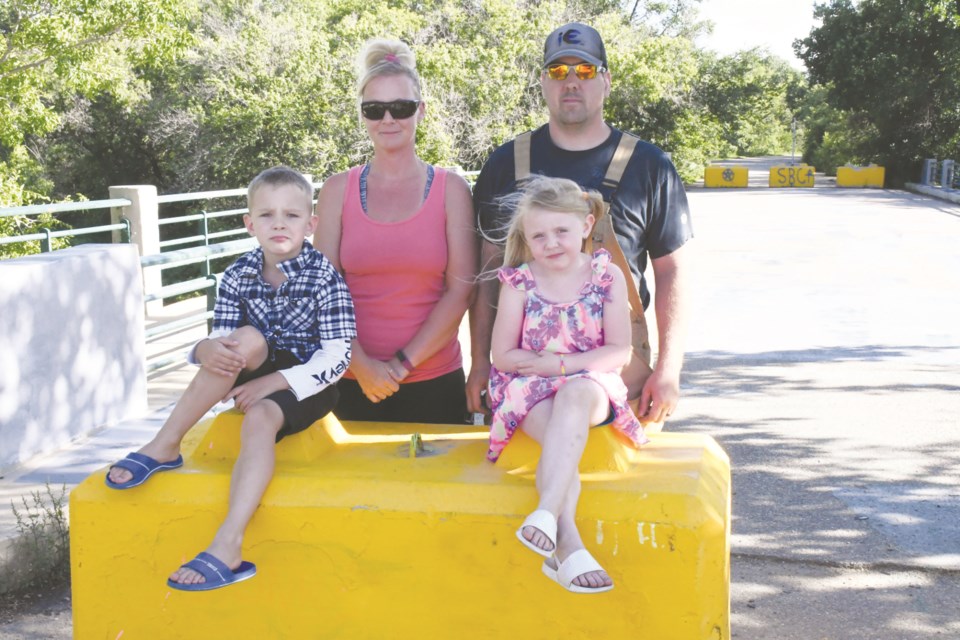The closure of the Seventh Avenue Southwest bridge has been stressful for parents Tim and Corrine Avery, as they have had to find creative ways to get their kids to school and themselves to work.
It would take the Averys about two minutes to drive into Moose Jaw if the bridge were repaired, but since it’s closed, it takes them at least 10 minutes to drive through the Valley View Centre (VVC) property and up Highway 2, Mr. Avery explained recently. This is a struggle since they — along with neighbours Jim and Deb Thorn — have to move barricades whenever they come and go.
Meanwhile, when she drove her kids to school, Mrs. Avery had to make six trips back and forth daily through the VVC property. This is because the kids — ages five and seven — start and finish school at different times, he continued. Making that amount of trips through that area can also be unsafe since many people use the Seventh Avenue Southwest road for regular walks.
“The major thing is (the bridge closure is) a huge inconvenience when you’re two minutes from town. And it’s such a small issue in my eyes, but I guess maybe not,” laughed Mr. Avery.
The Averys have managed to find a workable solution to ensure their children get to school. They have friends and family who wait for the kids on the north end of the bridge and then take them to school. This process is then repeated when the kids return.
This system might be awkward, but it’s necessary, especially since Mrs. Avery works at 4 a.m., Mr. Avery works at 6 a.m., and their babysitter cannot drive.
What’s also problematic is Prairie South School Division won’t send buses to the bottom of the bridge since there is no legal turnaround.
“I can’t blame them. They’re worried about getting the bus back up the hill. There’s no runway to get the bus up to speed. And if the city doesn’t clean the hill, that’s another issue they would have,” said Avery.
It’s a hassle for Avery to reach his home without a functioning bridge, he said. His father developed the property in 1979, while he moved his family there three years ago. He knew when he moved in that the municipality had closed the bridge in 2015. However, he figured city hall would do something to address the issue.
“They didn’t do anything. You would expect for them to put something on the capital budget plan, you know, when you have some sort of damaged infrastructure,” Avery said.
The Averys began receiving letters from the provincial government more than a year ago about their access through the VVC property after the province announced the complex’s permanent closure. This was when both families approached city hall to see what its plan was for the bridge.
It’s been “very, very frustrating” to deal with city hall, Avery said. City hall said it would keep them updated about the progress made on the bridge. However, Avery believes that promise fell short and communications broke down.
This forced the families to hire lawyer David Chow to help them. Avery thought it was “absolutely ridiculous” since he didn’t believe families should have to hire legal counsel to gain access to their property.
The last time Avery heard from city hall was two months ago.
“There’s not much feedback. They just keep telling us, ‘We’re working on it,’” he said, adding the city was supposed to make an announcement by July 31. “We’re running out of time.”
The Averys have no services of any kind, while Mr. Avery had to fight to have their garbage picked up. He pointed out that even residents in the adjacent rural municipality receive more services than them.
Avery wants city hall to fix the bridge, or at least allow the families to drive over one lane of the structure since part of it is steel. If pedestrians can cross a bridge that has inadequate guardrails, the families should be allowed to have vehicle access.
This part 10 in a series. Click here for part 1, here for part 2, here for part 3 and here for part 4, here for part 5, here for part 6, here for part 7, here for part 8 and here for part 9.
This series will continue.




